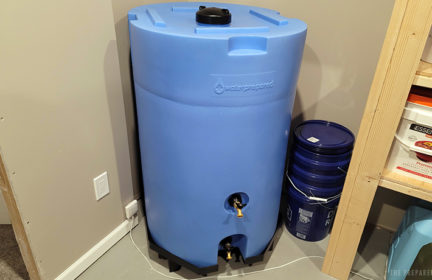Protecting homes from water infiltration
Across the northeast, many thousands of basements and crawlspaces have taken on water. I’m sure this will cost tens or hundreds millions of dollars to fix. A sizable number of these instances could have been easily avoided. Here are some quick thoughts from someone who diagnoses and fixes buildings for a living. Comments here are limited to rural and suburban homes not located in a flood plain.
First an anecdote regarding one of the houses I was in last night. Late in the evening one of my neighbors knocked on my door to help another neighbor who she said had around 2″ of water in their basement. I grabbed boots and a headlamp and headed over. Once in the basement I found the owner and 2 other neighbors pushing water towards a sump pump in the rear corner. The water problem was so serious that they noted a nearby basement window well was full of water, which was running down the wall and back into the sump.
<This might sound strange, but water infiltration is actually a window into the centuries old feud between religion and science, except that we currently live in something resembling the 1600s. Consequently, a great majority of people adhere to a religious perspective, which stipulates that the gods put water in basements, and there is nothing you can do to stop the basement water gods, aside from being a good person generally. Conversely, the profoundly unpopular scientific view stipulates that water in basements actually originates somewhere other than the basement, and remediation of water infiltration should see considerable effort devoted toward the prevention of water entry. Back to the story.>
Being an adherent to the scientific camp, I proceeded outside to investigate potential sources of water infiltration. Once there I discover that the sump outlet was directing most of its water into the window well. So three dudes pushing water into a sump that pushes water into a window well that leaks back into the house in an infinite loop, while Yakety Sax loudly plays in the background (maybe the music is just in my head).
My purpose here isn’t to ridicule my neighbors. It’s simply a window into the shortcomings of the nearly universal approach to this problem. In my experience the great majority of basement water infiltration is due to very remedial problems compounded by homeowners’ and technicians’ lack of sophistication, buttressed by their deeply held conviction that they’re a lot smarter than they are.
For every 1.5″ of rainfall, each horizontal square foot of your home will manage roughly 1 gallon of water. The footprint of most single family homes is probably over 1500 sq ft (think overhang, garages, porches, etc), which means that a lot of houses last night saw 6000 gallons. In a heavy rain, a single downspout and the ground around it might see over 1000 gallons of water. So this system has to have high integrity. What are some common problem areas?
- The roof deposits the water into a gutter via a flashing connection (drip edge) which directs water from the roof into the gutter. This drip edge has to be over the gutters. Gutters are often placed over the drip edge, which can direct water behind the gutter.
- The gutters must be sloped to downspouts (not aggressively 1/16″ per foot is fine) or they will overflow.
- The gutters must be free from debris or they will overflow.
- The gutter connection to the downspout must be robust, and the cutout from the gutter must be adequate (read that carefully – a large number of gutters simply have a hole to the downspout that’s too small).
- The downspouts and sump outlets should deposit water at least 10′ from the foundation where the grade slopes away from the house. (A corollary to this that I may cover later is that we usually don’t go over 20′ and we avoid tying multiple downspouts/sumps together!)
- I prefer to use 4″ PVC sub-grade to daylight wherever I can. Horizontal downspout extensions get stepped on by people with lawnmowers. Corrugated pipe extensions get knocked loose.
- Houses where the ground slopes toward the house may need to use grading and landscaping to direct water to the sides.
- Downspouts are often located in intractably stupid places, i.e. where water simply can’t be managed from the ground. Look up! Can you eliminate that downspout and pitch the gutter towards a different downspout? Can you redirect a substantial amount of water from an upper roof to an alternate downspout? At least half the homes I see have a significant opportunity to redirect water before it hits the ground.
One of the most effective ways to evaluate your drainage system is to walk around your house during a torrential rain. Look at every part of the system from the roof-flashing-gutter-downspout-drainage system. Does water pond against the house? Can you redirect it?
For advanced diagnosticians, here are some handy tips for interpreting symptoms and the nomenclature of homeowners or techs:
- Efflorescence is characterized by salt deposits on the inside of masonry walls. This will form in areas with longstanding moisture problems, meaning the foundation is staying wet for a very long time. Check for water sources on the outside. I play a fun guessing game from inside the basement called ‘where are your downspouts? Oh, there they are!’
- “My house has high water table.” = Water is getting into my basement and I don’t know why.
- “This whole neighborhood has high water table.” = My neighbors are idiots too.
- “The water is coming in through the floor.” = I don’t know where the water is entering and I’ve confused the low point in my basement slab with the point of entry.
Hope someone finds this helpful!
-
Comments (12)
-

